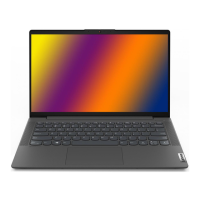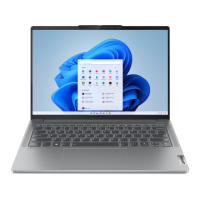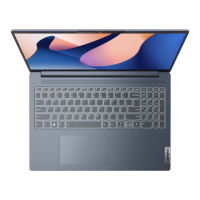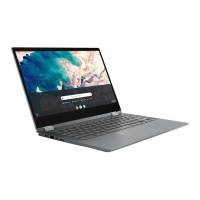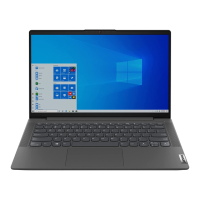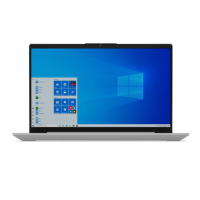Do you have a question about the Lenovo IdeaPad 5 Pro and is the answer not in the manual?
Details which Lenovo models the guide covers and notes potential visual differences.
States that instructions are based on Windows 10 and may not apply to other OS.
Informs users that content may change and directs them to the latest version online.
Details the front-facing components of the computer, including camera and microphones.
Describes the components located on the base of the computer, such as keyboard and touchpad.
Identifies and explains the ports and connectors found on the left side of the computer.
Identifies and explains the ports and connectors found on the right side of the computer.
Provides a comprehensive list of the computer's technical features and specifications.
Outlines the security measures and settings available for the computer.
Explains the data transfer speeds for various USB connection types.
Specifies the recommended temperature and humidity for operating the computer.
Guides users through the initial steps of setting up and starting with Windows 10.
Covers creating and managing local and Microsoft user accounts for Windows.
Instructions for setting up fingerprint and face recognition for secure login.
Identifies key icons and interface elements on the Windows desktop.
Explains how to check for and install Windows operating system updates.
Introduces Lenovo Vantage and PC Manager for system maintenance and updates.
Instructions for connecting to Wi-Fi networks and managing network settings.
Step-by-step instructions for connecting to wireless networks.
How to forget previously connected Wi-Fi networks.
How to enable and disable airplane mode for wireless connectivity.
Guide to accessing the Novo Button menu for system recovery options.
Steps to open and navigate the Novo Button menu.
Overview of ways to interact with the computer, including keyboard shortcuts.
Lists and explains the functions of various keyboard hotkeys.
Explains how to switch between hotkey and function key modes.
Settings and tips for managing the computer's power usage and battery life.
How to check battery levels and properly charge the device.
Customizing the action of the power button for sleep or other functions.
Information on power plans for optimizing performance and energy saving.
Steps to modify or create custom power plans for the computer.
How to switch between different performance modes for varied usage scenarios.
Accessing and configuring advanced system settings via UEFI/BIOS.
Explains the purpose and function of the UEFI/BIOS setup utility.
Procedures for entering the UEFI/BIOS setup interface during startup.
How to change the boot order for starting from different devices.
Steps to enable or disable the hotkey functionality in BIOS settings.
Setting the always-on functionality for USB ports via UEFI/BIOS.
Setting and managing passwords for enhanced system security in UEFI/BIOS.
Details the different types of passwords available in the UEFI/BIOS utility.
Steps to set the primary administrator password for BIOS/UEFI access.
Procedures to change or remove the administrator password.
How to set a secondary user password for BIOS/UEFI access.
Setting up a password prompt at system startup for added security.
Setting a password to protect unauthorized access to the hard disk data.
Procedures to change or remove hard disk passwords.
Options and steps for restoring or resetting the Windows operating system.
Summary of available methods for system recovery and reset.
How to use system restore points to revert the computer to a previous state.
Steps to manually create system restore points for future use.
How to select and apply a system restore point to fix issues.
Detailed steps for resetting Windows to its default configuration.
Guide on creating a bootable USB drive for system recovery.
Instructions on using the recovery drive to restore or reset Windows.
Answers to common queries regarding computer usage and troubleshooting.
Information on utilizing Lenovo's online tools and documentation for support.
Explanation of CRUs and their types for user replacement.
Lists the CRUs applicable to the specific product model and their categories.
Guidance on how to contact Lenovo customer support for assistance.
Information needed before contacting Lenovo support for efficient service.
Details on warranty services, contact numbers, and excluded support.
Information on acquiring extra services or extended support from Lenovo.
Information on Lenovo's commitment to accessibility and available features.
A list of useful keyboard shortcuts to improve computer usability.
How to use Windows accessibility tools for personalized computer settings.
Features like High Contrast, item size adjustment, and screen resolution.
Customizing keyboard and mouse settings for user preference.
Using Speech Recognition and screen reader technologies for input and output.
Tips for comfortable and healthy computer usage to prevent strain and discomfort.
Advice on maintaining good posture and taking breaks for comfort.
Guidance on display, chair, and limb positioning for optimal ergonomics.
How to use Night Light and adjust color temperature to reduce eye fatigue.
Statement regarding the computer's compliance with FCC regulations for radio frequency emissions.
Instructions on where to find the FCC and IC identification numbers on the computer.
Compliance statement specific to radio frequency regulations in South Korea.
Contains disclaimers, warranty information, and legal statements from Lenovo.
Lists trademarks owned by Lenovo and other companies.
| Color name | Cloud Grey |
|---|---|
| Form factor | Clamshell |
| Product type | Laptop |
| Product color | Gray |
| Housing material | Aluminum |
| Numeric keypad | No |
| Keyboard layout | QWERTZ |
| Keyboard backlit | Yes |
| Keyboard language | German |
| HD type | 2.8K |
| Color gamut | 100 % |
| RGB color space | sRGB |
| Display diagonal | 14 \ |
| Anti-glare screen | Always gives an optimal view, even in direct sunlight. |
| Display brightness | 400 cd/m² |
| Display resolution | 2880 x 1800 pixels |
| Native aspect ratio | 16:10 |
| Maximum refresh rate | 90 Hz |
| Operating system installed | Windows 11 Home |
| Operating system architecture | 64-bit |
| Processor cache | 16 MB |
| Processor cores | 8 |
| Processor model | 5800U |
| Processor family | AMD Ryzen™ 7 |
| Processor frequency | 1.9 GHz |
| Processor cache type | L2 & L3 |
| Processor manufacturer | AMD |
| Processor boost frequency | 4.4 GHz |
| Motherboard chipset | AMD SoC |
| Internal memory | 16 GB |
| Memory channels | Dual-channel |
| Memory form factor | On-board |
| Internal memory type | DDR4-SDRAM |
| SSD capacity | The Solid State Drive's storage capacity in Gigabytes. |
| SSD interface | M.2, NVMe, PCI Express 3.0 |
| Storage media | SSD |
| SSD form factor | M.2 |
| Total storage capacity | 512 GB |
| Number of SSDs installed | 1 |
| Battery capacity | 56.5 Wh |
| Battery life (max) | 10 h |
| AC adapter power | 65 W |
| Discrete graphics card model | Not available |
| On-board graphics card model | AMD Radeon Graphics |
| Audio chip | Realtek ALC3287 |
| Audio system | Dolby Atmos |
| Speaker power | 2 W |
| Number of built-in speakers | 2 |
| Privacy type | Privacy shutter |
| Front camera HD type | HD |
| Front camera resolution | 1270 x 720 pixels |
| Trusted Platform Module (TPM) version | 2.0 |
| Wi-Fi standards | 802.11a, 802.11b, 802.11g, Wi-Fi 4 (802.11n), Wi-Fi 5 (802.11ac) |
| Bluetooth version | 5.1 |
| Top Wi-Fi standard | Wi-Fi 5 (802.11ac) |
| Sustainability certificates | ENERGY STAR, ErP, RoHS |
| HDMI version | 1.4b |
| Headphone outputs | - |
| USB 2.0 ports quantity | 0 |
| Depth | 221 mm |
|---|---|
| Width | 312.2 mm |
| Height | 17.99 mm |
| Weight | 1380 g |
